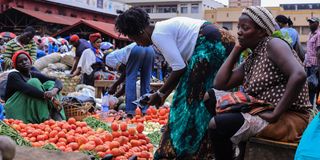Prime
Inflation remains flat as prices rise in 2021

A woman purchases tomatoes in Nakasero market. Much as inflation has been stable in 2021, food prices have remained high due to high fuel prices. PHOTO | EDGAR R. BATTE
What you need to know:
Annual headline inflation remained low and stable, and averaged 2.5 percent, largely due to low food crop inflation. But commodity prices rose sharply in the last quarter of the year.
Uganda’s inflation rate remained flat for most of 2021, indicating a slower rise in prices of goods and services during the year. But inflation projections remains high, as global producer and food prices have risen sharply in recent months.
In the macroeconomic & fiscal performance report financial year 2020/21 released on November 29 2021, the Ministry of Finance said during FY 2020/21, annual headline inflation remained low and stable, and averaged 2.5 percent, largely due to low food crop inflation, resulting from bumper harvests amidst subdued domestic and regional demand.
“The low and stable inflationary developments during the year contributed to the Central Bank’s decision to maintain an accommodative monetary policy stance to bolster economic activities,” the Ministry of Finance said in the report.
The computation by Uganda Bureau of Statistics shows that Uganda’s inflation rate has been trending in the bracket 1.9 percent and slightly above 2 percent for most of the time in 2021.
The executive director of research Bank of Uganda, Dr Adam Mugume told Daily Monitor recently that inflation averaged 2.2 percent in twelve months to October 2021.
Dr Mugume explained in the highlights of the monetary policy report that domestic inflation remained low in most of 2021 despite increases in foreign inflation. But there was a slow pickup in growth following the effects of the Covid-19 pandemic, decline in services inflation on account of closure of the education and entertainment sectors.
In the Monetary Policy statement of October 2021, the governor Bank of Uganda, Emmanuel Tumusiime Mutebile said inflation is projected to remain below target in the near-term as excess capacity continues to exert pressure downward on prices.
As demand recovers with full reopening of the economy and the release of pent-up demand, inflation is forecast to rise but stabilise around the 5 percent target, contingent on evolution of the pandemic and the efficacy of the vaccine.
However, he said inflation projection remains high pointing out that global producer and food prices have risen sharply in recent months and could persist.
Mr Mutebile said international commodity prices, especially oil and inputs have been on an upward surge since May 2020 and could rise beyond what the current projection assumes. He said this development could accentuate domestic cost pressure.
Going forward, Mr Mutebile says the risk of the current elevated inflation in most of the advanced economies could necessitate an early exit from accommodative monetary policies.
He also expressed fears that the resultant heightened volatility in the global financial market could lead to capital outflow and exert stronger weakening of the shilling, while the economy is still at a relatively early stage of recovery.
“On the downside, a faster resolution of global supply chain disruptions, softer international commodity prices, and another round of good crop harvests could cause inflation to remain subdued,” he said.
Bank of Uganda said international crude oil prices rose in the three months to September 2021. Uncertainty due to OPEC production levels and slowing growth in China caused fluctuation in oil prices during the quarter. Both Brent and WTI averaged $ 73/barrel and $ 70/barrel.
Against this backdrop, the Bank of Uganda has maintained CBR at 6.5 percent. This decision would be consistent with meeting the inflation target of 5 percent sustainably in the medium term.
The central bank uses monetary policy to control inflation, stabilise foreign exchange market and lending rate.
Core inflation is expected to average 2.2 percent in 2022, down from 2.6 percent in 2021 and Headline inflation is expected to average 3.4 percent in 2022, up from 2.2 percent in 2021.
The exchange rate appreciation trend continued into the quarter to September 2021 although depreciation pressures emerged towards the end of the quarter.
Meanwhile, the lending interest rates fell in the quarter to August 2021 to an average of 17.2 per cent down from 18.80 percent in the quarter to May 2021 in line with the accommodative monetary policy stance. Month on Month (M-o-M) however, lending rates increased in August 2021 to 18.3percent from 16.3percent in the previous month driven by loan extensions to trade, and household sectors.
Reopening economy
As demand recovers with full reopening of the economy and the release of pent-up demand, inflation is forecast to rise but stabilise around the 5 percent target, contingent on evolution of the pandemic and the efficacy of the vaccine.
However, he said inflation projection remains high pointing out that global producer and food prices have risen sharply in recent months and could persist.




